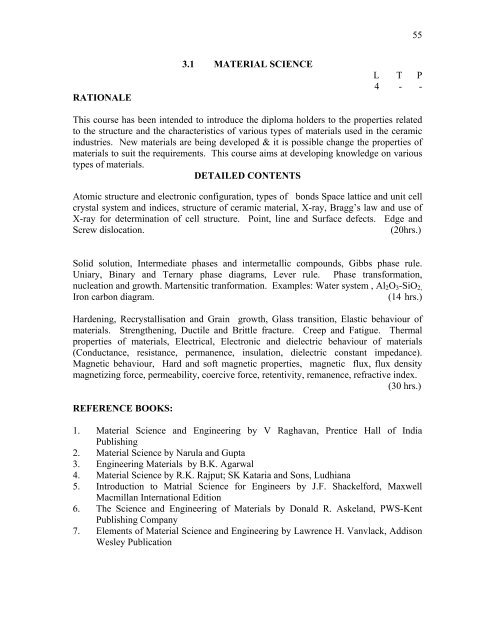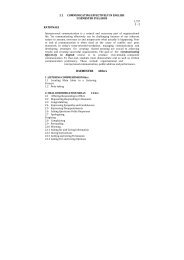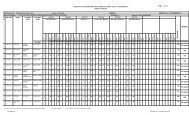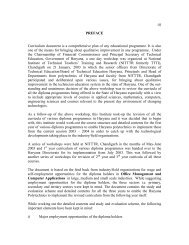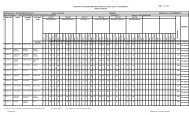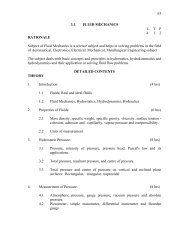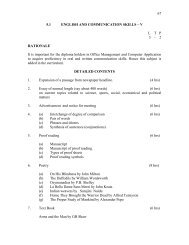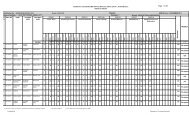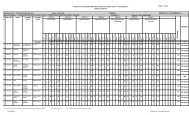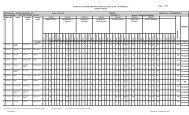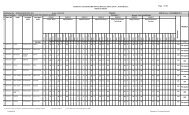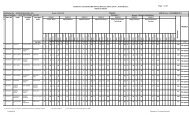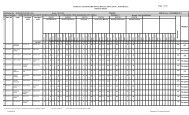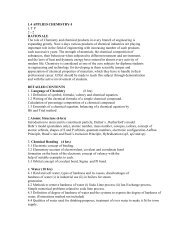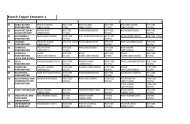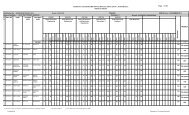55 3.1 MATERIAL SCIENCE L T P 4 - - RATIONALE ... - hsbte
55 3.1 MATERIAL SCIENCE L T P 4 - - RATIONALE ... - hsbte
55 3.1 MATERIAL SCIENCE L T P 4 - - RATIONALE ... - hsbte
You also want an ePaper? Increase the reach of your titles
YUMPU automatically turns print PDFs into web optimized ePapers that Google loves.
<strong>55</strong><br />
<strong>RATIONALE</strong><br />
<strong>3.1</strong> <strong>MATERIAL</strong> <strong>SCIENCE</strong><br />
L T P<br />
4 - -<br />
This course has been intended to introduce the diploma holders to the properties related<br />
to the structure and the characteristics of various types of materials used in the ceramic<br />
industries. New materials are being developed & it is possible change the properties of<br />
materials to suit the requirements. This course aims at developing knowledge on various<br />
types of materials.<br />
DETAILED CONTENTS<br />
Atomic structure and electronic configuration, types of bonds Space lattice and unit cell<br />
crystal system and indices, structure of ceramic material, X-ray, Bragg’s law and use of<br />
X-ray for determination of cell structure. Point, line and Surface defects. Edge and<br />
Screw dislocation.<br />
(20hrs.)<br />
Solid solution, Intermediate phases and intermetallic compounds, Gibbs phase rule.<br />
Uniary, Binary and Ternary phase diagrams, Lever rule. Phase transformation,<br />
nucleation and growth. Martensitic tranformation. Examples: Water system , Al 2 O 3 -SiO 2,<br />
Iron carbon diagram.<br />
(14 hrs.)<br />
Hardening, Recrystallisation and Grain growth, Glass transition, Elastic behaviour of<br />
materials. Strengthening, Ductile and Brittle fracture. Creep and Fatigue. Thermal<br />
properties of materials, Electrical, Electronic and dielectric behaviour of materials<br />
(Conductance, resistance, permanence, insulation, dielectric constant impedance).<br />
Magnetic behaviour, Hard and soft magnetic properties, magnetic flux, flux density<br />
magnetizing force, permeability, coercive force, retentivity, remanence, refractive index.<br />
(30 hrs.)<br />
REFERENCE BOOKS:<br />
1. Material Science and Engineering by V Raghavan, Prentice Hall of India<br />
Publishing<br />
2. Material Science by Narula and Gupta<br />
3. Engineering Materials by B.K. Agarwal<br />
4. Material Science by R.K. Rajput; SK Kataria and Sons, Ludhiana<br />
5. Introduction to Matrial Science for Engineers by J.F. Shackelford, Maxwell<br />
Macmillan International Edition<br />
6. The Science and Engineering of Materials by Donald R. Askeland, PWS-Kent<br />
Publishing Company<br />
7. Elements of Material Science and Engineering by Lawrence H. Vanvlack, Addison<br />
Wesley Publication
56<br />
<strong>RATIONALE</strong><br />
3.2 UNIT OPERATIONS IN CERAMICS<br />
L T P<br />
4 1 2<br />
A thorough knowledge of unit operations is essential for the study of ceramic<br />
engineering. This course acquaints the students with the basic principles of stochiometry,<br />
fluid mechanics, mechanical operations, heat transfer and mass transfer.<br />
DETAILED CONTENTS<br />
1. Introduction to unit operations and unit processes and their brief<br />
description, fundamental concepts<br />
2. Fluid Mechanics<br />
(4 hrs)<br />
(10 hrs)<br />
- Properties of fluids<br />
- Different types of flow (Laminar and Turbulent)<br />
- Viscosity<br />
- Relative motion between fluids and solids<br />
- Dimensional analysis<br />
- Measurement of flow of fluids (Manometer, venturimeter,<br />
rotameter, orificemeter, pitot tube)<br />
3. Heat Transfer<br />
(15 hrs)<br />
- Concept of heat transfer<br />
- Modes of heat transfer – conduction, convection and radiation<br />
Conduction<br />
- Conduction through composite walls<br />
- Fourier’s law, thermal conductivity, heat transfer coefficient<br />
Convection<br />
- Free and forced convection<br />
- Calculation of heat transfer coefficient, local and average heat<br />
transfer coefficient, heat temperature difference, fouling factor<br />
Radiation<br />
- Black body radiation, geometrical factor, grey body, Stefan –<br />
Boltzman law<br />
- Radiation from non-luminous gases<br />
- Radiation from luminous flames<br />
4. Mass Transfer<br />
(20 hrs)<br />
- The rate equation, driving force, fugacity and concentration, mass<br />
transfer by diffusion, diffusivity, mass transfer in turbulent flow.<br />
- Evaporation; Horizontal tube evaportor; vertical tube evaporator
57<br />
- Crystallization; Rate of crystallization, yield of a given operation,<br />
purity of product, size of crystals<br />
- Agitation; objectives and requirements, types of agitation<br />
equipments<br />
5. Mechanical Operations<br />
(15 hrs)<br />
Size reduction; objectives, stages of reduction – coarse size reduction,<br />
intermediate size reduction, fine size reduction. Screening; Industrial<br />
screening equipments, sieve analysis, determining particle size.<br />
Sedimentation: batch and continuous equipments, equipments like<br />
thickners, filter press, cyclone separators, dryers<br />
LIST OF PRACTICALS<br />
1. To study the sieve analysis of the product obtained from ball mill, crusher and<br />
grinder<br />
2. Measurement of viscosity from viscometer<br />
3. To study the sedimentation behaviour of slurry<br />
4. Study of filtration efficiency through filter press<br />
5. To measure the thermal conductivity of insulating materials<br />
6. To measure diffusivity of solids in liquid or gas<br />
RECOMMENDED BOOKS<br />
1. Unit Operations of Chemical Engineering by Mcabe and Smith, McGraw Hill<br />
Publication<br />
2. Unit Operations Vol. I & II by Chatterjii, Khanna Publishers, New Delhi<br />
Publication<br />
3. Heat Transfer by DQ Kern<br />
4. Mass Transfer Operation by Treybal<br />
5. Chemical Engineering I & II by Coulson & Richardson, Pergamon Press<br />
Publication<br />
6. Introduction to Chemical Engineering by Badger and Banchero, McGraw Hill<br />
Publication
58<br />
3.3 PRINCIPLES OF METALLURGY<br />
<strong>RATIONALE</strong><br />
L T P<br />
3 - -<br />
Material play an important role in any industrial applications. A diploma holder must be<br />
aware of and conversant with the different types of materials available, their properties,<br />
uses, and availability to enable him to make a judicious choice for a given application.<br />
This course has been designed to cover the above aspects so that diploma holder can<br />
perform his functions confidently.<br />
It also includes the various treatments done on metals to improve their properties.<br />
DETAILED CONTENTS<br />
1. Classification (8 hrs.)<br />
Metals and non metals ferrous & non ferrous metals and their alloys in brief.<br />
2. Engineering Properties Of Materials (18 hrs.)<br />
- Physical Properties:- Density, Heat Capacity, Specific heat, Thermal<br />
Conductivity Thermal Expansion, Porosity and Denseness.<br />
- Mechanical Properties:- Stress and Strain (Tensilc, Compressive, Shear).<br />
Elastic limit, Yield point, Yield strength, Resilence, Plasticity, Ductility,<br />
Malleability, Brittleness, Toughnes, Impact strength, Modulus of elasticity,<br />
compliance, Tensile, Compressive and Shear strength, Fusibility, Weldability<br />
and Mechanic ability, Hardness and Hardenability, Fracture, toughness,<br />
Bending.<br />
3. Heat Treatment Of Steel (12 hrs.)<br />
Definition and importance, Annealing, Normalis Hardening, Tempering.<br />
Martempering, Austempering. Developments in heat treatment process, Surface<br />
hardening process- Carburizing, Nitriding and Flame hardening.<br />
4. Powder Metallurgy (10 hrs.)<br />
Powder production, Powder mixing, Compaction and Sintering, Advantages and<br />
its limitations, Application of Powder metallurgy.
59<br />
RECOMMENDED BOOKS<br />
1. Engineering Metallurgy by V.Sivraj<br />
2. Metallurgy for Engineers by C. Ojal<br />
3. Material Science and Metallurgy by R.B. Choudhary, Khanna Publishers, New<br />
Delhi<br />
4. Material Science by Van Valen.
60<br />
<strong>RATIONALE</strong><br />
3.4 ENGINEERING THERMODYNAMICS<br />
L T P<br />
3 1 -<br />
It is a core subject of Chemical Engineering and is essential for understanding basic<br />
concepts, thermodynamic properties of fluids & performance of thermal systems used in<br />
industry.<br />
DETAILED CONTENTS<br />
1. Introduction & basic concepts (11 hrs)<br />
Systems, processes & surroundings, homogenous & heterogeneous systems,<br />
closed, open & isolated systems, intensive & extensive properties, state & path<br />
functions. Concept of internal energy, enthalpy, entropy, free energy &<br />
equilibrium. Equation of state, ideal gas law, Vander Waal’s eqn., Amagat’s law,<br />
Dalton’s law, Henry’s law, Raoult’s law, Zeroth law of Thermodynamics.<br />
2. First law of Thermodynamics for open & closed systems. (8 hrs)<br />
Calculation of internal energy, enthalpy, heat and work for ideal gas undergoing<br />
reversible, isometric, isothermal, isobaric, adiabatic and polytropic process<br />
3. Second law of Thermodynamics (8 hrs)<br />
Entropy change and its calculations for a closed & open system, Carnot’s<br />
cycle and its efficiency, thermodynamic temperature scale, reversible &<br />
irreversible process.<br />
4. Third Law of Thermodynamics and its Applications (3 hrs)<br />
5. Applications of the laws of thermodynamics (10 hrs)<br />
Refrigeration coefficient of performance, vapour compression<br />
refrigeration system, absorption refrigeration, properties & applications of<br />
refrigerants, reciprocating air compressors; single stage compressor, isothermal<br />
efficiency, volumetric efficiency, clearance & clearance volume.<br />
6. Phase equilibria (8 hrs)<br />
Vapour liquid equilibria, dew point and bubble point and their calculations for<br />
two phase systems, Gibbs Duhem Equation.
61<br />
RECOMMENDED BOOKS:<br />
1. Introduction to Chemical Engineering Thermodynamics by Smith and Vanness,<br />
Mc Graw Hill.<br />
2. Chemical Engineering thermodynamics by K.V. Narayanan, Prentice Hall India.<br />
3. Chemical Engineering Thermodynamics by Dodge, Mc Graw Hill.<br />
4. Chemical Engineering Thermodynamics by YVC Rao.<br />
5. Engineering Thermodynamics by PK Nag<br />
6. Thermal Engineering by Balleny
62<br />
3.5 FUELS AND FURNACES<br />
<strong>RATIONALE</strong><br />
L T P<br />
4 1 2<br />
Ceramic materials are manufactured at high temperature so the knowledge of fuels and<br />
furnaces is necessary for proper processing and quality products. Moreover ceramic<br />
materials are also used for high temperature applications therefore, for their<br />
characterization knowledge of fuels and furnaces are required.<br />
DETAILED CONTENTS<br />
1. Theory of combustion:- combustion reactions, Actual air required for<br />
combustion. Theoretical and excess air, Calorific value and the total heat<br />
produced.<br />
(8 hrs.)<br />
2. Types of fuels:- Solid, Liquid and Gaseous fuels. (30 hrs.)<br />
Solid Fuels:- Coal and Coke, Classification of coal, Properties of coal.<br />
Combustible and Non-combustible constituents, Ignition temperature, Pulverised<br />
coal, its utilisation. Coke as secondary fuel. Its properties and Uses. Testing-<br />
Proximate analysis, Ultimate analysis & Calorific value.<br />
Liquid fuels:- Indian resourcs, types, properties of various petrolum products,<br />
Testing of liquid fuels, Octane and Cetane number, Calorific value, flash point<br />
and fire point, Viscosity determination, Burner for liquid fuels. (atomizer, cup &<br />
cone burner, squirrel gauge)<br />
Gaseous fuels:- Its advantage over solid and liquid fuels, Natural gas, L.P.G.,<br />
Properties, Burner of gaseous fuels.<br />
Testing-Calorific value determination, Orsat analysis.<br />
3. Furnaces:- Definition, Classification, types of furnaces-Gas, Oil and Coal fired<br />
furnaces, Electrical furnaces, Regenerators and Recuperators, Annealing furnaces.<br />
(10 hrs.)<br />
4. Kilns:-Continuous and Batch type, Downdraft, Shuttle Tunnel and Rotary Kilns,<br />
Elementary idea of temperature measurement, Pyrometers-Resistance, Electrical<br />
Gas, Thermocouples- Types and standardisation.<br />
(10 hrs.)<br />
5. Elementary idea about kiln design. ( 6 hrs.)
63<br />
LIST OF PRACTICALS<br />
1. To determine the moisture content of a given fuel<br />
2. To determine the calorific Value of coal by bomb calormeter coal .<br />
3. To determine the flash point of a given fuel.<br />
4. Determination of viscosity of oil Redwood viscometer or Torsion viscometer.<br />
5. To determine the Water absorption by different raw materials (powders).<br />
6. Elementary idea about furnace and kiln design.<br />
7. To determine coefficient of thermal conductivity of single wall.<br />
8. Thermocouple calibration<br />
9. Proximate analysis of coal.<br />
10. Determination of total Grindability of coal<br />
RECOMMENDED BOOKS<br />
1. Elements of Fuels, Furnaces and Refractories by O.P. Gupta.<br />
2. Industrial Chemistry by Jain and Jain.
64<br />
<strong>RATIONALE</strong><br />
3.6 CERAMIC RAW <strong>MATERIAL</strong>S<br />
L T P<br />
3 - -<br />
This subject has been designed to introduce the diploma holders to the properties related<br />
to the structure and the characteristics of various types of specialized materials used in<br />
the ceramic industries. The usage of these materials in various industries is also covered<br />
in this subject.<br />
THEORY<br />
DETAILED CONTENTS<br />
1. Plastic Raw Materials:- (6 hrs.)<br />
Introduction, Geology, mineralogy, classification of residual clay, transported<br />
Kaolin, Ball Clays, Stone ware Clay, fire clay, Alumina clays. Bentonite, Brief<br />
clays, loess & their properties & use in ceramic industries<br />
2. Non-clay Plastic raw materials:- (5 hrs.)<br />
Tale, steatile pyrophyllite (Agalamatolith) sericite pyrophyllite & their properties,<br />
use in ceramic industries<br />
3. Non-Plastic raw materials:- (6 hrs.)<br />
Silica, Quartz, Sandstone, Ganister, Quartizite, Sand, Flint, Diatomite & their<br />
prpoerties & use in ceramic industries.<br />
Feldspar, Cornish stone, Nepheline syenite, Pumic or Volcanic ash, Perlite, Bone<br />
ash, Apatite, Tricalcium Phosphate & their properties & use in ceramic Industry.<br />
4. Other Alumina & Silica Containing raw materials:- ( 5hrs.)<br />
Silimanite, Kyanite, Andalusite & their properties & uses.<br />
5. Frit Making: (8 hrs.)<br />
Involving smelting, Quenching, Drying & milling. Study of furnaces related to<br />
enamel firing. Batch making of ground coat, cover coat enameling.<br />
6. Glaze:- (6 hrs,)<br />
Introduction, raw materials, properties of raw materials of glaze (including optical<br />
properties like reflectance, opacity etc.), batch making, mixing, milling.
65<br />
7. Type of Glaze: (6 hrs.)<br />
Raw glaze, transparent glaze, opaque glaze, coloured glaze, matt glaze, lead<br />
glaze, leadless glaze, crystalline glaze etc.<br />
Opacifiers, colors, coloring oxide like iron oxide, cobalt oxide, copper, chromium,<br />
venedium, zircon etc.<br />
8. Enamels: (6 hrs.)<br />
Introduction, raw materials for enamels, its properties. Application method of<br />
Enamels & Glazes: Drying & brushing, spraying, dipping, pouring, screen<br />
printing etc. Decoration : Underglaze, onglaze, inglaze.<br />
RECOMMENDED BOOKS<br />
1. The Science and Engineering of Materials by Donald R. Askeland, PWS-Kent<br />
Publishing Company<br />
2. Elements of Material Science and Engineering by Lawrence H. Vanvlack,<br />
Addison Wesley Publication<br />
3. Material Science and Engineering by V Raghavan, Prentice Hall of India<br />
Publishing<br />
4. Ceramics, Mastering the Craft by Richard Zakin, American Ceramic Society<br />
Publication
66<br />
<strong>RATIONALE</strong><br />
3.7 CEMENT TECHNOLOGY<br />
L T P<br />
3 1 4<br />
This specialized subject is taught to the diploma holders of ceramic engineering in order<br />
to widen their scope of employment so as to cover all cement manufacturing units also.<br />
DETAILED CONTENTS<br />
1. Definition, Classification of cements, Types of cement their properties and phases<br />
of cement.<br />
(8 hrs.)<br />
2. Raw materials, their selection and proportionality, Calcareous and Argillacious<br />
materials, Additives, Manufacture of cement (wet and dry process). (10 hrs.)<br />
3. Effect of raw materials and constituents on the properties of cement.<br />
Calculations of raw mix. Thermo chemistry of clinker formation, sequence of<br />
reaction, hydration of portland cement, setting and hardening of portland cement,<br />
physical and mechanical properties of portland cement.<br />
(12 hrs.)<br />
4. Lime and other building materials, Different classes of lime, Their properties,<br />
Uses.<br />
(6 hrs.)<br />
5. Gypsum and plaster of paris, setting and hardening of plaster of Paris, its uses.<br />
(6 hrs.)<br />
6. Testing of cement-Initial setting time, Final setting time, fineness. (6 hrs.)<br />
LIST OF PRACTICALS<br />
1. Determination of fineness of cement.<br />
2. Determination of water cement ration.<br />
3. Determination of initial & final setting time of cement.<br />
4. Determination of initial & final setting time of Gypsum.<br />
5. Determination of initial & final setting time of Plaster of Paris.<br />
6. Determination of soundness of cement by Le Chatteliers apparatus.<br />
7. Determination of tensile strength of cement mortar cubes.<br />
8. Determination of tensile strength of lime mortar cubes.<br />
Determination of compressive strength of cement mortar cubes.<br />
9. Determination of compressive strength of lime mortar cubes.<br />
10. Determination of chemical analysis of cement.<br />
RECOMMENDED BOOKS<br />
1. Text Book of Cement and Concrete by Lee<br />
2. Advances in Cement Technology by S.M. Ghose


